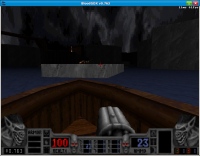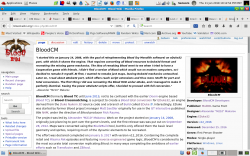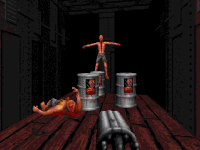Blood:10th Anniversary
Introduction (By Tchernobog)[edit]
So here we are, with the Blood Wiki celebrating its tenth birthday in the same year as Blood II: The Chosen will mark its twentieth, and with the original Blood having already hit its own twentieth anniversary milestone last May. At the Blood Wiki we have been marking each occasion with its own animated banner, but by far the most fitting tribute the game has received in the past year was BloodGDX, the most complete modern Blood port ever released. When we first founded the Blood Wiki ten years ago I never really thought that we would reach this point, certainly not just through the application of reverse engineering and the clever usage of leaked Blood Alpha source code. Over a full decade on from when I first joined it, the Blood community still possesses the ability to surprise me.
A year ago I played F.E.A.R. for the first time, a game which still loomed large as Monolith Productions most successful title when the Blood Wiki was founded, and yet it did not take me long to realize that F.E.A.R. was already older then than either Blood or Blood II were when I first properly played them back in 2007. I am not one of the "Great Old Ones" of this community, which stretches all the way back to vintage Usenet posts and of course the venerable Planet Blood website, but I have now been a Bloodite for about as long as I was alive before it, and a great deal of my adolescence and young adulthood has been devoted to documenting it. We have been helped along the way by a great many Bloodites of both new and longstanding, and I would like to take a moment to thank a few of them in particular.
My first heartfelt thanks has to go to William Weilep, who took the Blood Wiki under his wing in 2011 by hosting it as part of his DeathMask infrastructure, and has been supporting it that way ever since. Early in the life of the Wiki we were given a great deal of support from Eric J. Juneau, the most accomplished fan fiction author in our community, who also established the foundation of a great deal of our articles. This Wiki would be far less complete without him. Over on the Transfusion Forums I have made a great deal of friends who have also greatly encouraged me to keep the effort going, and of course every single contribution made by any one individual on this Wiki is greatly appreciated. Last but certainly not least, I would like to thank User:Gideon as well as the rest of my family for the support they have given to this project as well.
Where we go from here is certainly up to question. By far the largest single contribution I have made to the Blood Wiki over the past year was enabling video support, meaning we now have a sizable archive of Blood video files to compliment the rest of our growing collection. What is next for me and the Blood Wiki though I do not know. What is not in doubt is that I will continue to be here, swatting down spam bots on a regular basis, and pondering the next big thing I hope to add to the project that has already taken up such a great deal of my life. Because if I can show that amount of passion for this, just imagine what the rest of our diverse community can accomplish, especially with such triumphs as a reverse engineered source port already under our belts. May the Blood long continue to flow.
Introduction (By Gideon)[edit]
"Monolith currently has no plans to revive the Blood franchise, but you never know what could happen in the future!" — Monolith Productions, March 2007
Ten years ago the Blood community was entering uncertain times. The Transfusion project, by far the community's greatest champion, was drifting off into its present slumber. Blood and Blood II were vanishing into memory, long beyond being current, but not quite the retro chic they are considered now. Monolith Productions had moved on to other and more successful things (though not quite having lost its knack for signing off the rights to their games without a care, as Craig Hubbard has noted), and hopes for a new instalment vanished into the ether. Windows XP and Windows Vista had gradually eroded native DOS support, leaving Blood only available on legacy hardware or chugging under DOSBox emulation at a time of weaker and largely still single core processors. It looked like obscurity would be the fate of our beloved franchise, and yet this was not the end.
In this climate, though unbeknownst to us perhaps, my brother and I launched our wiki. Inspired by the Doom Wiki, which remains a cracking good read (and whose coverage of fan maps I can only dream we can match one day), we desired to create a similar tribute to a game that had been captivating us for the past year. We had first played the shareware off of DOSGames.Com (the same site that first introduced us to Doom, Duke Nukem 3D and Quake I back in the day) back in 2005 and were haunted by its dark locales and gravelly voiced protagonist. Ignorant of the actual plot, we substituted our own about evil Catholic monks raising an undead army in the 1950s. While a part of me would still like to play that game, it paled compared to what we found when we played it proper in May 2007.
Blood was what birthed in me a taste for the macabre and gothic, and helped immerse me in the horror genre. It provided the pinnacle of the game design I loved in Doom and Duke Nukem 3D, assisted by featuring the most intriguing anti-hero in a first person shooter. It also, despite all its campy charm, has the only plot of a Build engine game that anyone can really take seriously. It was the plot above all else that lead us to write this wiki, as a tome of (near) forgotten lore. If anything my appreciation for its brilliant gameplay only developed fully in time. Reading through the Blood II background material, and even, if not even more notably, the collection of fan fiction for the games made me a writer. This was not the only thing the wiki developed for me, as researching for it has taught me a lot about art, technology and of course slaughtering Mimes, or at least just jumping over them to get to secrets.

As it turns out, Blood was going to be just fine. Starting with Rage Against the Machine in November 2007, the original game enjoyed a renaissance of fan additions such as Bloody Pulp Fiction (2009) and the recently reissued Death Wish (2011). In the shadow cast by Transfusion, other conversions of Blood were appearing such as Blood TC/ZBlood in 2006, the beginnings of BloodCM in 2008, and even the quaint if severely limited Blood Reborn in 2010. Most importantly of all was the digital re-release of the games on Good Old Games in April 2010, later followed by similar releases by Atari and on Steam. Finally the game was back in the limelight and accessible to a new audience, and our wiki was there to light the way. Long the domain of ageing enthusiasts, retro PC gaming seems to have entered a new and vibrant golden age.
Sadly not all of our problems have gone away. The Blood source code remains as illusive as ever, even if BloodGDX provides a largely palatable alternative; as well as the others working on their own solutions to the problem. The game rights languish between multiple parties, and unfortunately it seems they are some of the few people involved who would not jump at the chance to remake or relaunch the game. From Night Dive, to Interceptor and most notably of all former CEO of Monolith Jason Hall, it seems many are just chomping at the bit for fresh blood. For now however, we do our best to keep what we have from coagulating. Particularly I am proud to have saved some of our earliest heritage from the digital dark age, such as ye olde days of Planet Blood. However, I am also pleased with how we have helped promote and inspire new bloody creations. As always, the festival of Blood continues!
Contributions[edit]


Top ten Blood Wiki contributors as of January 12, 2018:
- Gideon: 17494 Contributions
- Tchernobog: 9138 Contributions
- Willis: 1751 Contributions (2 for voting, 1 for testing, rest wiki importing)
- TheWallflower: 1316 Contributions
- Cerberus: 388 Contributions
- Clari87: 247 Contributions (22 as Corbyn)
- 3371-Alpha: 178 Contributions (38 as an unregistered user)
- Tenpazen: 147 Contribution
- Drudge Master: 116 Contributions
- Cheogh: 53 Contributions
For all other contributors expand here:
- Ishmael: 50 Contributions
- PikaCommando: 38 Contributions
- Kadorhal: 33 Contributions
- ZZaRDoZz: 26 Contributions
- Cplrhumm: 17 Contributions
- Racruvido: 14 Contributions
- Blaze Ventura: 13 Contributions
- TheUnbeholden: 10 Contributions
- Minion: 8 Contributions
- Rautamiekka: 8 Contributions
- WiiStation360Games: 8 Contributions
- Jack Kellar: 7 Contributions
- Flea Friend: 7 Contributions
- Killerklowns: 7 Contributions
- DiamondClaw: 6 Contributions
- Nuthriz: 5 Contributions
- Barbara: 5 Contributions
- Kitsuneae: 5 Contributions
- FraX: 5 Contributions
- Dead King: 5 Contributions
- Giveall: 4 Contributions
- Reconite: 4 Contributions
- MarkMcWane: 4 Contributions
- Sir Seizhak: 3 Contributions
- Quadratic Lemon: 3 Contributions
- Smk: 3 Contributions
- Theelder: 3 Contributions
- Kalevi: 3 Contributions
- Popsoap: 3 Contributions
- Sacorguy79: 3 Contributions
- Tecman: 2 Contributions
- Daffidaff: 2 Contributions
- Catherine: 2 Contributions
- DoomMarine23: 2 Contributions
- DOSGuy: 1 Contributions
- Chris591: 2 Contributions
- LigH: 2 Contributions
- Manfesto: 1 Contribution
- Meatgoat: 1 Contributions
- DustyStyx: 1 Contribution
- Doctorhelp: 1 Contribution
- MattSaettler: 1 Contribution
- Istfemer: 1 Contribution
- Nenni: 1 Contribution
- WendyDawson: 1 Contribution
- Bloodmaster: 1 Contributions
- TeenBeach: 1 Contribution
- JBJblaze: 1 Contribution
- Victus: 1 Contribution
- Nyarlathotep: 1 Contribution
For more statistics see the "See Also" section!
See Also[edit]
- First Anniversary Page
- Second Anniversary Page
- Third Anniversary Page
- Fourth Anniversary Page
- Fifth Anniversary Page
- Sixth Anniversary Page
- Seventh Anniversary Page
- Eighth Anniversary Page
- Ninth Anniversary Page
- Tenth Anniversary Page
- Eleventh Anniversary Page
- Twelfth Anniversary Page
- Thirteenth Anniversary Page
- Fourteenth Anniversary Page
- Fifteenth Anniversary Page
- Sixteenth Anniversary Page

